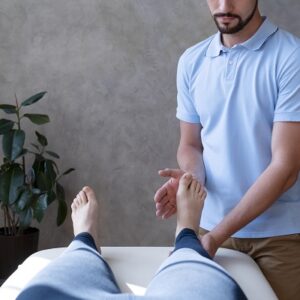How to Test Myotomes is One of the most important tools for assessing the flexibility and strength of the muscles in the body is the myotome test. Testing myotomes is measuring how well a muscle contracts in response to an outside force that is applied by a professional. Tests on myotomes are performed to determine whether any anomalies, such as muscle weakness, exist.
Table of Contents
With the myotomes approach, you can measure your muscle groups’ strength and flexibility by doing a variety of motions. The practitioner will use their hands or other equipment, depending on the situation, to impart resistance to the myotome. Lifting the arm against the practitioner’s hand’s resistance is one way to test myotomes for the shoulder, for instance. Myotome testing can be crucial in determining the presence of any potential muscle imbalances or weakening. Finding problems early on can help prevent them from getting worse or from causing pain or harm. Myotomes testing can help you get the diagnosis and treatment you need to feel better and remain healthy if you are experiencing discomfort or stiffness in your muscles.
If you have questions about myotome testing, speak with your physician or other medical professionals. They can offer you guidance throughout the procedure and suggest a medical professional skilled in myotome testing. You may obtain the knowledge and assistance you need to feel your best thanks to their expertise. How to Conduct Examinations Myotomes are a vital physical examination method that are used to evaluate the nervous system’s anatomical and functional integrity, with a focus on motor function. This test evaluates the strength and range of motion of myotomes, which can be aberrant in myopathy, myasthenia gravis, and Guillain-Barre syndrome, among other diseases.
Read More: Along with How to Test Myotomes read More about the Myotome and Dermatome.
Procedure

C5: Shoulder Ab-Duction
The C5 myotome is related to the muscles that abduct the shoulder. The deltoideus anterior and middle parts, the supraspinatus muscle, and the infraspinatus muscle are among the muscles that make up the C5 myotome.
Position of Therapist and Subject-How to Test Myotomes
- In order to test your C5 myotome, ask the patient to take a comfortable seat or stand, with their arms relaxed by their sides.
- Next, raise one arm to shoulder height or slightly above by slowly raising it to the side.
- After counting to five, the therapist now applies resistance to shoulder abduction. Proceed with the opposite arm in the same manner.
- Note down the results and contrast the two arms’ strengths.
C6: Elbow Flexion & Wrist Extension
With the myotome test, you may check the health of particular muscle groups by putting them to the test. An example of a myotome test is the elbow flexion and wrist extension test, which is used to evaluate the strength and coordination of the nerves that govern the hand and arm muscles.
Position of Therapist and Subject-How to Test Myotomes
- In order to conduct this myotome test, the patient must bend their elbow to a 90-degree angle and point their forearm straight up toward the ceiling.
- Now, the therapist checks the biceps muscle by applying resistance.
- In order to evaluate the forearm extensors, also known as wrist extension, The therapist provides resistance to your wrist as you hold it extended and keep your fingers relaxed with your palm pointing downward.
- Carry out the same process on the opposite side.
- Note down the results and contrast the two arms’ strengths.
C7: Elbow Extension & Wrist Flexion
The particular muscles or muscle groups that are evaluated during a physical examination are referred to as myotomes. The C7 nerve root’s myotomes are in charge of flexion at the wrist and extension at the elbow.
Position of Therapist and Subject-How to Test Myotomes
- The patient will be asked to execute wrist flexion against resistance and elbow extension (to test triceps) in order to evaluate the function of the myotome. Carry out the same process on the opposite side.
- Carry out the same process on the opposite side.
- Records should be kept. Perform a thorough assessment and diagnosis if the patient exhibits any pain, numbness, weakness, or other symptoms.
- Check out each side’s relative strength.
C8: Finger Flexion
The intrinsic hand muscle and the forearm finger flexor muscles are part of myotome C8, the eighth cervical myotome. Myotome testing is used to detect impairment or malfunction in the neural pathways that supply different muscle groups.
Position of Therapist and Subject-How to Test Myotomes
- A hand grip test will be conducted to evaluate the myotome C8.
- Request that the patient make a tight fist with the practitioner’s fingers.
- Even when the physician tries to remove the fingers, tell the patient to hold on to them.
- For the other side, repeat the process.
- Record your results and compare the two hands to determine the asymmetry and strength.
- Look for any obvious atrophy of the thenar, hypothenar, and intrinsic hand muscles in the hands of the patients.
C8: Finger Abduction & Adduction
Myotomes are a class of muscles that are tested separately and assessed according to the movements they can do. The finger abduction and adduction test, which evaluates finger strength, coordination, and range of motion, is one myotome test.
Position of Therapist and Subject-How to Test Myotomes
- The patient spreads their fingers as widely apart as they can while the therapist resists, which is how the myotome test is carried out.
- A healthy myotome is demonstrated by the patient’s ability to perform this motion with efficiency.
- On the opposite side, repeat the process.
- To examine strength and asymmetry, record your findings and compare the two hands.
- Observe whether the thenar, hypothenar, and intrinsic hand muscles exhibit any apparent atrophy in the hands of the patients.
C8 & T1: Thumb Opposition
In physical therapy, myotomes are a kind of muscle testing used to measure and analyze each myotome’s particular muscle strength. The myotomes in the upper extremities are evaluated in the C8 & T1-Thumb Opposition Test.
Position of Therapist and Subject-How to Test Myotomes
- Toe the thumb toward the little finger, ask the patient to do so.
- You can use your index finger to apply resistance to this movement.
- For the other thumb, repeat.
- Write down your findings (weakness in a patient during a myotome test may be a sign of a problem with that region’s muscle function).
- Check out each side’s relative strength.
L1 and L2: Hip Flexion
A group of muscles called myotomes are examined to assess the health of the nerve roots. In a myotome test, muscles are usually contracted or observed and scored. Hip flexion, or the capacity to bend at the hips, is a feature shared by the L1 and L2 myotomes.
Position of Therapist and Subject-How to Test Myotomes?
- An individual would normally be requested to lie comfortably supine and raise one leg toward the ceiling in order to test this myotome.
- Try to resist the patient’s hip movement as much as possible as they execute SLR.
- After noting your findings, repeat for the opposite leg.
- Examine each side’s strength in comparison.
L3: Knee Extension
A medical test called the Knee Extension Myotome, or Myotome L3, is used to measure the lower limb muscles’ neurological strength.
Position of Therapist and Subject-How to Test Myotomes
- The patient is usually asked to lie on their back with one leg bent in order to complete the myotome L3 test.
- After applying resistance with their hands around the patient’s ankle, the practitioner will instruct the patient to straighten their leg.
- After noting your findings, repeat for the opposite leg.
- Examine each side’s strength in comparison.
L4: Ankle Dorsiflexion
The sciatic nerve and the group of muscles in front of the leg are linked to the L4 myotome, also known as the fourth lumbar myotome.
Position of Therapist and Subject-How to Test Myotomes
- Ask the patient to lie comfortably supine with their heels off the bed in order to test the L4 myotome.
- Give the patient a gentle hand on his ankle and instruct him to pull his foot towards his face while applying resistance.
- Record your findings, then repeat with the opposite foot.
- Examine each side’s strength in comparison.
L5: Great Toe Extension
By having the patient execute a flawless toe extension, myotome L5, or the fifth lumbar myotome, can be tested. This examination can identify myotome L5 pathology or injury-related weakness, like a sprained ligament in the foot or ankle.
Position of Therapist and Subject-How to Test Myotomes
- Request that the patient rest comfortably on the bed in order to test the L5 myotome.
- The patient is requested to extend their great toe, maintain a straight knee, and flex their ankle during this examination.
- This movement is met with opposition from the therapist.
- The patient should be able to fully and rapidly stretch their great toe if their myotome L5 is working properly.
- Record your findings, then repeat with the opposite foot.
- Examine each side’s strength in comparison.

S1: Ankle plantar Flexion and Ankle Eversion
A neurologic examination known as the Myotome S1 evaluates the sensitivity, strength, and range of motion in body parts innervated by the first sacral nerve root. Myotome S1 is used to examine ankle plantarflexion, which involves pointing the foot downward, and eversion/knee extension, which involves moving the foot outward. Soleus and Gastrocnemius.
Position of Therapist and Subject-How to Test Myotomes
- Ask the patient to lie comfortably supine on the bed with their heels off the bed in order to test the L5 myotome.
- Tell the patient to apply as much pressure as they can on your hand while you hold their sole.
- Record your findings, then repeat with the opposite foot.
- Examine each side’s strength in comparison.
S2: Knee Flexion
The myotome test for S2 measures the strength of the hamstrings and gluteal muscles in the back of the thigh by means of manual muscle testing. It is a procedure used to evaluate knee flexion strength.

Position of Therapist and Subject-How to Test Myotomes
- A patient for an S2 myotome test usually lies on their stomach with their knees relaxed and straight.
- Tell the patient to flex their knee in opposition to resistance.
- Next, the patient’s knee flexion strength is assessed by the healthcare professional applying light pressure to the top of the patient’s foot.
- A normal myotome S2 test result shows that there is no discernible weakness in the gluteal or hamstring muscles, confirming neuromuscular functioning and solid motor control in the lower limbs.
- Record your findings, then repeat with the opposite foot.
Summary of How to Test Myotomes
Myotomes, which are composed of many muscles with varying motion capabilities, are tested by having patients perform a range of movements that correspond to different spinal nerves. This is because individual muscles can make up several myotomes.
Frequently Asked Questions – How to Test Myotomes
Q: Differentiate between myotomes and dermatomes?
Ans: The skeletal muscle cells known as myotomes are responsible for regulating the movement of myofascial (muscle) tissue. One kind of myotome that gives skin sensation is dermatomes.
Q: Why should we test myotomes?
Ans: These tests are a component of the neurological examination, which verifies the nervous system’s strength, coherence, and innervation structures.
Q: How are myotomes formed?
Ans: Myoblasts are the progenitor cells that give rise to myofibers, and they are what form myotomes. Myotubes are created when myoblasts unite to generate myofibers. Muscle fiber is composed of separate myotomes, which are further divided from these myofibers. Myotomes, which regulate muscle action, are the fundamental building blocks of the body’s motor innervation.

One Response